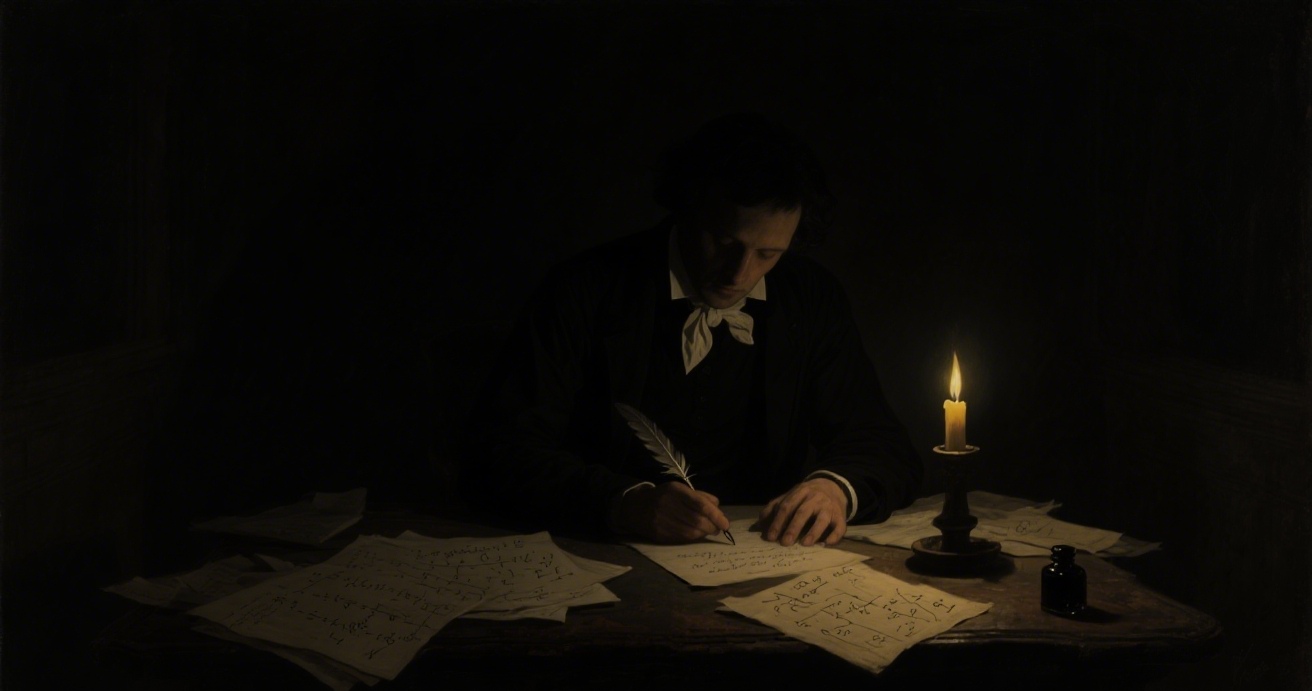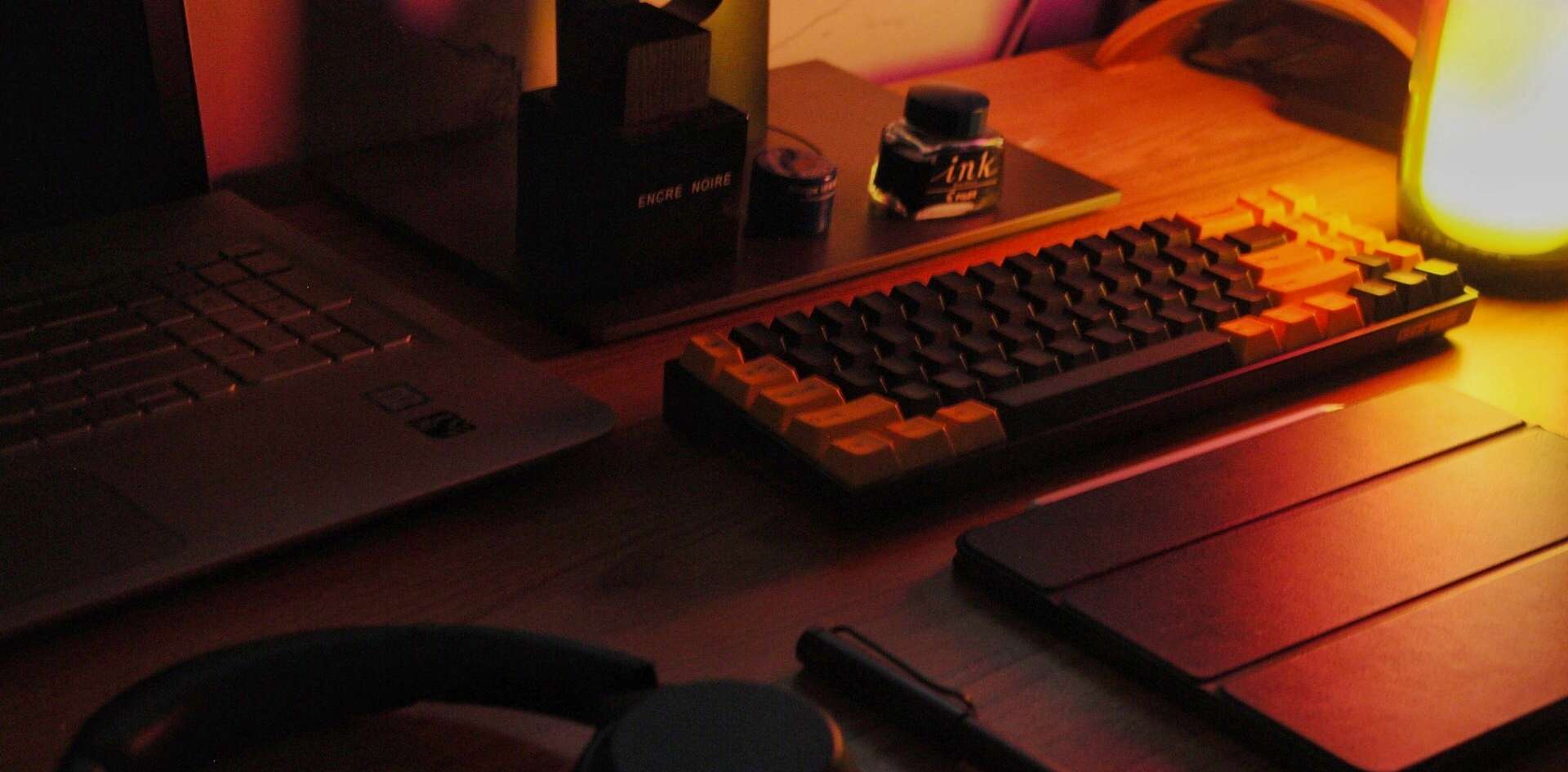伽罗瓦传(The Galois Chronicles)

伽罗瓦传(The Galois Chronicles)
Aurorp1g数学界不朽的传奇,英年早逝的天才少年!!!伽罗瓦的名字对数学专业的学生来说并不陌生。他对数学界产生了很深远的影响,现代科学很多理论都离不开他提出的群论。他的天才和智慧将永远铭刻在数学史的长河中。
墨水与星辰:伽罗瓦传
序章:晨雾中的低语
塞纳河畔的雾气正织就暮春的幕布,二十一岁的伽罗瓦蹲在石板路上,怀中被雨水洇透的纸页仿若浸血的月光。他用指尖摩挲着那些尚未干涸的墨迹——那是他用生命淬炼的群论公式,试图破解五次方程的最后谜面。
“埃瓦里斯特!”远处教堂的钟声惊起一滩白鹭。伽罗瓦的瞳孔在晨光中骤缩为针尖,四年前路易 - 勒格拉学校的旧影正从雾中浮现:少年在煤油灯下狂草代数的刹那,数学老师曾用颤抖的指尖触碰他的纸张,惊呼中带着不祥的预感。
雨丝突然变得滚烫起来。伽罗瓦看见柯西的白发在科学院的大厅飘动,那双浑浊的眼睛正将他未完成的论文揉成纸团;狱中的铁窗正泛起血色锈痕,面包屑在潮湿中生出霉斑,他用这些肮脏的颗粒推演置换群的轨迹;而那个曾与他在图书馆偷情的女学监女儿,此刻正从雾中走来,手中攥着染血的百合花。
决斗的号角穿透云层。伽罗瓦将沾满泥渍的手稿折成纸船,任其随塞纳河漂流至断头台旧址。当第一缕晨光撕裂巴黎的穹顶,少年的体温正在胸膛的弹孔处冷却,而他留在手稿封底的预言正被雨水晕染成谶语:“群的舞步将跨越永恒,而第五个根永远无法用尺规丈量。”
第一章:天才的诞生
埃皮纳勒小镇的晨雾尚未散尽,伽罗瓦的羽毛笔已在羊皮纸上划出尖锐的轨迹。十四岁的他站在高高的脚凳上,踮起脚尖够着父亲书房最高书架上的《几何原本》。窗外的栗子花簌簌落了他一头,少年却浑然不觉,指尖已将欧几里得的命题揉成流沙。那座古老的修道院钟楼在晨光中泛着铅灰色,正与他瞳孔里旋转的方程组相互映照。
第一次踏入巴黎综合理工学院的礼堂时,少年的马裤上还沾着晨跑溅起的泥点。他攥着皱巴巴的录取通知书,像手持圣徒遗物般庄重。讲台上,柯西的白发在烛光里飘动,三角板碰撞出清脆的声响:“五次方程的根式解将彻底颠覆数学的根基。”伽罗瓦的笔尖顿住,墨水在草稿纸上洇出一朵黑色的罂粟花。
第二章:群论的诞生
午夜的图书馆里,微弱的烛光在羊皮纸上投下少年的侧影。伽罗瓦的羽毛笔如饥饿的蝗虫啃噬着纸页,那些在柯西论文里被视为“荒诞”的置换群,正从他笔下流淌出灵性的韵律。墨水瓶逐渐干涸,他沾着自己的血迹续写公式,直到掌心凝结出暗红的晶钻。
“数学的真谛不在数字,而在它们的舞蹈。”他对着窗棂上的蜘蛛低语,却惊动了藏书室深处的女学监。玛德琳娜的裙裾扫过书架时带起灰尘,她将一朵干枯的鸢尾花别进少年的领口,指尖触到他滚烫的额头:“你的头脑比巴黎七月的空气更炽热。”
当伽罗瓦将沾满血渍的论文交给法兰西科学院时,泊松的白手套几乎被染红。柯西在廊柱后暗笑,他将那叠泛黄的纸页塞进壁炉:“孩子的狂想曲,比不上拉格朗日的奏鸣曲。”火焰吞噬墨迹的瞬间,少年的瞳孔里闪过断头台的寒光。
第三章:革命与监狱
七月革命的硝烟尚未散尽,伽罗瓦已将三色旗裹在肩头。他在街垒间挥舞着父亲留下的佩剑,刀刃与火药气交织成致命的华尔兹。当反叛军的尸体被塞纳河吞没,他将缴获的军用手枪对准自己太阳穴——却被玛德琳娜的纤指挡住:“为数学而死,比为自由而死更值得。”
监狱的铁窗在月光下泛起青色锈痕。伽罗瓦用生锈的汤匙在石墙上刻下置换群的公式,面包屑在潮湿中生出霉斑,他用这些肮脏的颗粒推演群的结构。某夜,他听见玛德琳娜在走廊尽头哼唱《马赛曲》,旋律里混着铁链拖动的节奏。
第四章:宿命的决斗
四月的巴黎开满血腥味的丁香花。伽罗瓦在阁楼里写最后一封信,墨水与血迹在信纸上纠缠成凄美的图案。他将手稿折成纸飞机,任其掠过断头台旧址,坠入塞纳河的淤泥。玛德琳娜的裙裾在街角飘动,她将一朵染血的百合别进他的纽扣孔:“记住,数学比爱情更永恒。”
决斗场的晨雾尚未散尽,阳光透过树梢在青石板上绣出金色花纹。伽罗瓦的影子被拉得很长,像一支横卧的几何尺。当子弹穿透胸膛的瞬间,他看见方程的解在眼前化作漫天繁星,而玛德琳娜的裙摆在晨风中飘成血色晚霞。
尾声:永恒的群论
巴黎医学院的太平间弥漫着松木与死亡的气息。伽罗瓦的遗体被草草裹在白布中,唯一能证明他身份的,是胸前那张沾满血渍的方程式草稿。他的兄弟取走手稿时,发现背面写着:“我的思想将比星辰更永恒。”
多年后,那些被遗弃的手稿在阁楼积灰中重见天日。数学家们惊愕地发现,伽罗瓦用生命铸就的群论,竟成为现代数学的基石。当他的公式被刻在卢森堡公园的大理石上时,晚霞正将塞纳河染成血色 —— 仿佛二十一岁的少年从未离去,只是化作方程式里永恒的变量,继续在数字的宇宙中舞蹈。
Ink and Stars: The Galois Chronicles
Prologue: Whispers in the Dawn Mist
The mist along the Seine wove a curtain over late spring. Twenty-one-year-old Galois squatted on the cobblestones, his rain-stained papers glowing like moon-kissed blood. His fingers traced the still-wet ink — equations of group theory, his life’s essence poured out to crack the quintic equation’s final riddle.
“Évariste!” A church bell’s chime startled a flock of egrets into flight. Galois’s pupils shrank to pinpricks as memories surfaced through the mist: four years prior, in his youth at the Lycée Louis-le-Grand, his math teacher had trembled as he touched the young man’s paper, his cry carrying an ominous foreboding.
The rain turned scalding. Galois envisioned Cauchy’s white hair floating in the Academy’s hall, those turbid eyes crumpling his unfinished paper; prison windows rusted blood-red, bread crumbs molding as he traced permutation groups with them; and the schoolmistress’s daughter who’d dallied with him in the library, now approaching from the mist with blood-stained lilies.
As the duel’s horn pierced the clouds, Galois folded his mud-spattered manuscript into a paper boat. It drifted down the Seine past the old guillotine site. With the first dawn light splitting Paris’s dome, the youth’s warmth cooled in the bullet hole in his chest, his final prophecy on the manuscript’s back blurring in the rain: “The group’s dance will outlast eternity, and the fifth root can never be measured with a ruler and compass.”
Chapter 1: The Birth of a Prodigy
The morning mist of Épinal had not yet lifted when Galois’s quill was already etching sharp lines on parchment. At fourteen, he stood on a tall stool, toes barely touching, reaching for Euclid’s Elements on the highest shelf of his father’s study. Chestnut blossoms fell on his head, but the young man was oblivious, his fingers already turning Euclid’s propositions into sand. The ancient convent bell tower glowed lead-grey in the dawn light, mirroring the equations spinning in his pupils.
When he first stepped into the amphitheater of the École Polytechnique, mud splattered on his breeches from his morning run. He clutched his crumpled acceptance letter like a holy relic. On the podium, Cauchy’s white hair floated in the candlelight, the triangle ruler clinking crisply: “The quintic equation’s radical solution will upend the foundations of mathematics.” Galois’s pen froze, ink blooming into a black poppy on the scratch paper.
Chapter 2: The Birth of Group Theory
In the midnight library, the faint candlelight cast the youth’s silhouette on parchment. Galois’s quill devoured the paper like a ravenous locust. The permutation groups deemed “absurd” in Cauchy’s papers now flowed with spiritual rhythm from his pen. As the inkwell emptied, he continued writing with his own blood, until dark red crystals formed on his palms.
“Mathematics’ essence lies not in numbers, but in their dance,” he whispered to a spider on the window lattice, unaware of the headmistress approaching from the library’s depths. Mademoiselle’s skirt swept up dust as she tucked a withered iris into the young man’s collar, her fingertips touching his feverish forehead: “Your mind burns hotter than Paris’s July air.”
When Galois handed his blood-stained paper to the French Academy of Sciences, Poisson’s white gloves nearly turned red. Cauchy snickered behind a column, shoving the yellowed pages into the fireplace: “A child’s fantasy, no match for Lagrange’s symphony.” As flames consumed the ink, the youth’s pupils flashed with the guillotine’s寒光.
Chapter 3: Revolution and Prison
The July Revolution’s smoke had not yet cleared when Galois draped the tricolor over his shoulders. He swung his father’s sword in the street barricades, the blade and gunpowder weaving a fatal waltz. As rebels’ bodies were swallowed by the Seine, he pressed his father’s military pistol to his temple — only to have Mademoiselle’s纤指 block it: “Dying for mathematics is worthier than dying for freedom.”
Prison windows gleamed with blue rust under the moon. Galois carved permutation group formulas on the stone walls with a rusty spoon, molding moldy面包屑 into group structures. One night, he heard Mademoiselle humming “La Marseillaise” at the corridor’s end, the melody mingling with the rhythm of dragging iron chains.
Chapter 4: The Fated Duel
In April, Paris was awash with丁香花 carrying a bloody scent. Galois wrote his final letter in the attic, ink and blood intertwining into a poignant pattern on the paper. He folded the manuscript into a paper airplane, letting it soar past the old guillotine site and plummet into the Seine’s silt. Mademoiselle’s skirt fluttered at the street corner as she pinned a blood-stained lily to his buttonhole: “Remember, mathematics outlasts love.”
The dawn mist had not yet lifted at the duel ground. Sunlight filtered through the trees, embroidering golden patterns on the cobblestones. Galois’s shadow stretched long, like a prostrate geometric ruler. As the bullet pierced his chest, he saw the equation’s solution burst into a sky of stars, while Mademoiselle’s skirt fluttered into a blood-red evening glow in the morning breeze.
Epilogue: The Eternal Group Theory
The Paris Medical School’s morgue reeked of pine and death. Galois’s body was hastily wrapped in a shroud, his identity proven only by the blood-stained equation manuscript on his chest. When his brother took the manuscript, he found on the back: “My thoughts will outlast the stars.”
Years later, those abandoned manuscripts resurfaced from attic dust. Mathematicians were shocked to find Galois’s group theory, forged in his life’s final moments, had become modern mathematics’ bedrock. As his formulas were carved into Luxembourg Garden’s marble, the evening glow dyed the Seine blood-red — as if the twenty-one-year-old youth had never left, but transformed into an eternal variable in the equation, continuing to dance in the universe of numbers.












